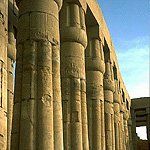

 | The Sphinx is one of the best known monuments of Ancient Egyptian Architecture. Unusual to the form of most Egyptian pyramid structures, it stands as a symbol of the strength of the Ancient Necropolis of Giza and as a homage to the strength of the King. The Sphinx was originally commissioned by Kaphre (a son of Cheops), and was constructed from bedrock found within the Valley of Giza. The age of the Sphinx has been estimated to be roughly 4,636 years old and it dates from the time of the Fourth Dynasty. When construction began is not entirely known, the identity of the architect is not known either, though the alignment of the Sphinx with the Pyramid of Kaphre suggests a political affiliation. |
The pyramids of Giza, are perhaps the only true rival to the Great Sphinx, when one thinks about Ancient Egypt and it's architecture. The valley of Giza with it's wonderful monuments, is truly a marvel of architectural prowess. The three Pyramids, consist of The Great Pyramid of Khufu, The Pyramid of Kafhre and The Pyramid of Menkaura. Each Pyramid is a tomb to a different King of Egypt.
 All three pyramids were built during the Third and Fourth Dynasty, and were monumental undertakings of the king and the kings sons. The Pyramid of Khufu has a base which covers roughly a nine acre area (roughly 392,040 square feet). The pyramid of Menkaura, unlike the other pyramids, had one tier of it's base covered in granite. The pyramid of Khafre, had a two tier base encased in granite. Unfortunately like many of the great Kings of the Old Kingdom of Egypt, the Pyramid of Menkaura, Khufu, and Kafhre were not finished in the time of the end of the Kings reign. In the case of Menkaura, the king died before it's construction was completed. The monuments of Giza and the entire Giza valley stand as a marvelous reminder of the skill executed in the creation of the pyramids, and are truly fabulous to see. An investigational trip to Kom Abou Billou in Lower Egypt by the University of Michigan led them to the tombs of ancient Terenouthis in 1935. They found Terenouthis in (March to April 1935). Under the direction of Enoch E. Peterson the site at Kom Abou Billou was excavated. In 1961, the 197 funerary steles recovered from this site and now published by Finley Hooper, Professor of History at Wayne State University, in the Kelsey Museum Studies series. Roger McCleary, Ph.D. from the University of Toronto, has embarked upon a reexamination of these sculptures and their chronology and meaning. Some items recovered from the grave included a stele, painted plaster from the tomb's interior, jewelry, a Roman coin dating to the end of the third century AD and, an ushabti. |
 | "The Temple at Luxor, Thebes, though founded on an older sanctuary and, like most temples, altered and repaired subsequently, is substantially the work of Amenophis III, apart from a great forecourt, with pylons, added by Rameses II. It was dedicated to the Theban triad, Amun, Mut and Khons. The illustration shows remains of the forecourt, with papyrus-bud capitals and a seated colossus of Rameses, connected by twin colonnades, 53 m (174 ft) long, to a lesser court by Amenophis in the distance. The twin colonnades of bell-capital columns, 12.8 m (42 ft) high, were the only part ever built of a grand hypostyle hall projected by Amenophis, or by the last king of his dynasty, Horemheb. Amenophis III also built a mortuary temple on the west bank at Thebes, but little survives except the twin seated statues of himself, originally 20.8 m (68 ft) high, famous from ancient time as the Colossi of Memnon." |

